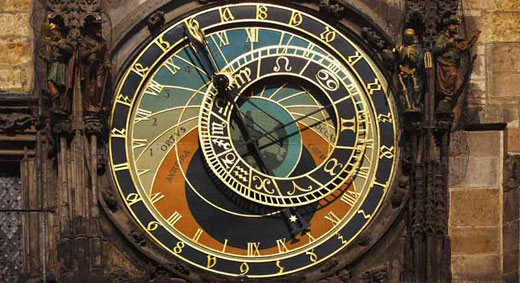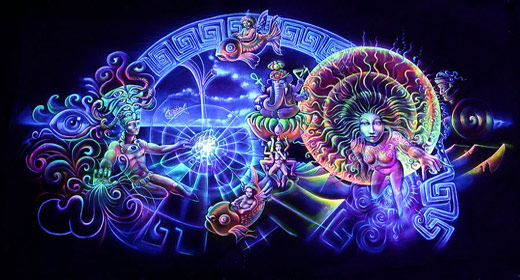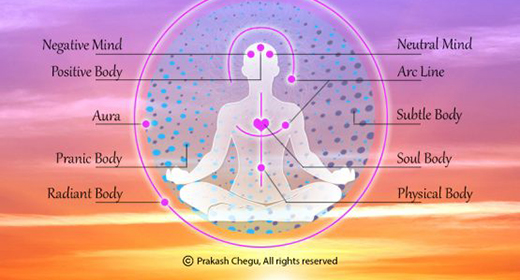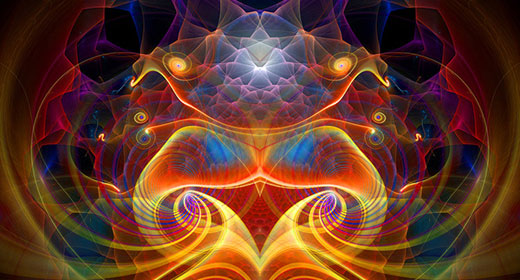Stanislav Grof, M.D., Ph.D.: Holotropic Research and Archetypal Astrology.

In the concluding article in this section, Stanislav Grof addresses the interface between transpersonal psychology and the astrological perspective, describing his collaboration
with Richard Tarnas and the connections they discovered between the planetary archetypes and the psychodynamics of the unconscious. This paper, previously unpublished, presents the remarkable evidence in support of archetypal astrology from Grof’s research into non-ordinary states of consciousness over the last five decades.
Psychedelic substances, in general, and LSD, in particular, can profoundly influence the functioning of the human psyche. Depending on the personality of the individual who takes them and on the “set and setting,” their effect can be extremely beneficial or deleterious.
Two people can take the same substance, the same dosage, in the same location, and yet have radically different, even diametrically opposite experiences. For this reason, since the beginning of psychedelic experimentation, researchers have attempted to find ways of predicting what impact these substances would have on the person who takes them.
The effort to discover a method for predicting the reaction to psychedelics and the therapeutic outcome was one of the objectives of a large clinical study that our research team conducted at the Maryland Psychiatric Research Center in the 1960s and 1970s. We used forthis purpose a battery of standard psychological tests, including the Minnesota Multidimensional Personality Inventory (MMPI), Shostrom’s Personal Orientation Inventory (POI), the Rorschach Inkblot Test, our own Psychedelic Experience Questionnaire (PEQ), and others. This research confirmed my earlier findings at the Psychiatric Research Institute in Prague, Czechoslovakia, and the conclusion from the study of professional literature, that the results of the tests developed and commonly used by Western psychology were essentially useless in this regard.
Ironically, when after years of frustrating effort I finally found a tool that made such predictions possible, it was more controversial than psychedelics themselves. It was astrology, a discipline that, even after years of studying transpersonal phenomena, I myself tended to dismiss as a ridiculous pseudoscience. I came to realize, however, that astrology could be an invaluable tool in the work with both psychedelics and with other forms of non-ordinary (or “holotropic”) states of consciousness such as those induced by powerful experiential techniques of psychotherapy (primal therapy, rebirthing, and holotropic breathwork) or occurring spontaneously during psychospiritual crises.
The radical change in my attitude toward astrology has been the result of collaboration with psychologist and philosopher Richard Tarnas, my close friend and colleague. For over three decades, beginning in 1976, we have been jointly exploring the astrological correlates of mystical experiences, psychospiritual crises, psychotic episodes, psychedelic states, and holotropic breathwork sessions. This work has shown that astrology, particularly the study of planetary transits, can predict and illuminate both the archetypal content of non-ordinary states of consciousness and the timing of when particular states are most likely to occur. Our systematic study of the correlations between the nature and content of holotropic states and planetary transits convinced me that a combination of deep experiential therapy with archetypal psychology and transit astrology is the most promising strategy for the future development of psychiatry and depth psychology.
Astrology and Modern Western Science
I am aware that this is a very strong statement, particularly in view of the fact that many mainstream scientists consider astrology, as I did myself, to be in principle incompatible with the scientific world view. Like many other esoteric systems, astrology was one of the victims of the rationalism and materialism of the Scientific Revolution. It was rejected not on the basis of scientific proof that its premises were false, but because of its incompatibility with the fundamental metaphysical assumptions of Western science dominated by monistic materialism. More specifically, there are several important reasons for the dismissal of astrology by materialistic scientists.
First, Western science portrays the universe as an impersonal and largely inanimate mechanical system, a supermachine that created itself and is governed by mechanical natural laws. In this context, life, consciousness, and intelligence are seen as more or less accidental products of matter. By contrast, the basic assumptions of astrology are that the cosmos is a creation of superior intelligence, that it is based on an inconceivably intricate deeper order, and that this order reflects a higher purpose. The astrological perspective closely reflects the original meaning of the Greek word
Kosmos that describes the world as an intelligibly ordered, patterned, and coherently interconnected system with humanity as an integral part of the whole. In this view, human life is not the result of random forces ruled by capricious chance, but follows an intelligible trajectory that is in some way attuned to the movements of celestial bodies and can thus be at least partially intuited.
Second, because astrological thinking presupposes the existence of archetypes — timeless primordial principles underlying and informing the fabric of the material world—it recognizes a dimension of reality that cannot be detected using techniques of modern science. Under the influence of positivist materialism, science only recognizes the existence of hidden, invisible dimensions of reality if these can be made accessible through the use of devices that extend the range of our senses, such as microscopes, telescopes, or sensors detecting various bands of electromagnetic radiation. The archetypal dimension clearly does not fall into this category.
The tendency to interpret the world in terms of archetypal principles first emerged in ancient Greece and was one of the most striking characteristics in Greek philosophy and culture. The archetypes can be seen from several different perspectives. In the Homeric epics they took the form of personified mythological figures, as deities, such as Zeus, Poseidon, Hera, Aphrodite, or Ares. In the philosophy of Plato, they were described as pure metaphysical principles, the transcendent Ideas or Forms, that possessed independent existence of their own in a realm not accessible to ordinary human senses. In modern times, C. G. Jung brought the concept of archetypes into modern psychology, describing them primarily as psychological principles. For all Jung’s efforts, however, and despite his attempts to formulate his theory based solely on empirical observation of the psyche, the existence of archetypes is usually either ignored or summarily dismissed by the scientific establishment.
Third, another major obstacle for seriously considering astrology is the exclusively deterministic thinking in Western science. The universe is seen as a mechanistic chain of causes and effects and the principle of linear deterministic causality is considered to be mandatory for all processes in the universe. One major disquieting exception to this rule, the origin of the universe and the question of the “cause of all causes,” is seldom mentioned in scientific discussions. Deterministic causality is the only type of influence many critics of astrology can usually imagine and take into consideration. And the idea of a direct material effect of the planets on the psyche and the world is, of course, implausible and absurd.
Finally, the emphasis that astrology puts on the moment of birth does not make any sense in academic psychology and psychiatry, which generally do not see biological birth as a psychologically relevant event. Academic and clinical psychiatrists typically use a very narrow conceptual framework limited to postnatal biography and the Freudian individual unconscious. They do not usually recognize the perinatal level of the unconscious pertaining to the deep-seated memory of the birth trauma and its powerful influence on the adult personality and biographical experiences. The rejection of the psychological significance of birth is based on the highly questionable assumption that the brain of the newborn cannot register the traumatic impact of the birth experience, because the process of myelinization (formation of the fatty myelin sheaths covering the neurons) in his or her brain is not fully completed at the time of birth.
Evidence for Astrology from Holotropic Research
Since the 1950s, however, several decades of systematic research of holotropic states have generated vast amounts of data that undermine these basic assumptions of materialistic science and bring supportive evidence for astrology. These observations reveal:
1. the existence of transpersonal experiences that point to an ensouled cosmos permeated with consciousness and creative cosmic intelligence
2. the possibility of direct experience of spiritual realities, including archetypal figures, motifs, and realms, and empirical validation of the authenticity of these experiences
3. the critical psychodynamic importance of the birth experience for the psychological development and life of the individual
4. the existence of synchronicities that represent an important and viable alternative to the principle of mechanistic causality
5. the striking correlations between the psychodynamics of the birth process and the planetary archetypes associated with the four outer planets
6. the extraordinary predictive potential of astrological transits for the nature, timing, and content of holotropic states of consciousness
7. the recognition of the profound connections between the archetypal pattern of birth charts and COEX systems in the individual psyche
8. the relationship between astrological world transits and patterns of incidence and diagnosis of psychopathology.
1. Evidence for an ensouled cosmos:
The study of holotropic states of consciousness has brought strong evidence that transpersonal experiences cannot be dismissed as irrelevant psychotic products. The fact that these experiences apparently provide access to accurate new information about various aspects of existence strongly suggests that they are phenomena suigeneris.
We have observed innumerable cases in which subjects described information about past eras or specific historical events, or detailed subjective descriptions of animal behavior or plant life, that the individual had not known nor had access to prior to the experience, yet which proved upon subsequent research to be accurate. Challenging the most fundamental assumptions of materialistic science, transpersonal experiences suggest that human consciousness is continuous with the inner nature of the universe, which from this perspective appears to be a unified web of events in consciousness permeated by interiority and intelligence. Such experiences provide empirical evidence suggesting that the individual human psyche is part of a greater psyche that has no boundaries and is essentially commensurate with all of existence. They thus confirm a basic tenet of many esoteric systems, including astrology, that the microcosm “mirrors” the macrocosm. This notion, which appears completely absurd from the perspective of mechanistic science, has in recent decades received unexpected support from several new theories and developments in the sciences. The development of lasers, optical holography, David Bohm’s holographic model of reality in quantum physics, and Karl Pribram’s holographic model of the brain have suggested radical new possibilities concerning the relationship between the part and the whole.
2. Empirical support for the existence of archetypes:
Holotropic states provide direct experiential access to spiritual or numinous dimensions of existence, including the archetypes. This is important because the concept of archetypes is essential for astrology, as it is being understood here. As we have seen, in the twentieth century, C. G. Jung resurrected the ancient idea of archetypes and introduced them into modern depth psychology in the form of psychological principles, primordial organizing patterns of the psyche. He and his followers explored and described in great detail the important role that archetypes play in the life of individuals, nations, and nature. Many professional articles and books, as well as popular literature written by authors with a Jungian orientation, suggest that our personal characteristics and behavior reflect the dynamics of powerful archetypal principles and that we enact typical archetypal themes in our everyday life.
Most academic psychologists and psychiatrists have so far considered Jung’s idea of the archetypes to be unfounded and speculative and have refused to take it seriously. However, modern consciousness research has confirmed the existence of archetypes beyond any reasonable doubt by showing that in holotropic states of consciousness they can actually be directly experienced. I have published in other contexts case histories illustrating how transpersonal experiences involving archetypes can provide new information about mythological realities of cultures unknown to the experiment and open new therapeutic possibilities (Grof 1985, 1988, 1992, 2000, 2006).
An important characteristic of the archetypes is that they are not confined to, and do not originate from, the human brain, but operate from transcendental realms and exert a synchronistic influence on both individual psyches and events in the physical world. The marriage between astrology and archetypal psychology based on Jung’s work represents an extraordinary advance in both fields. It brings the mathematical precision of astronomy into the interior and imaginative world addressed by depth psychology, enriching enormously thepossibilities of theoretical speculations as well as clinical predictions.
3. Psychological significance of birth:
The work with holotropic states has corrected the astonishing misconception of much academic psychiatry that the only way that biological delivery can have any consequence for the individual’s mental condition, emotional life, and behavior is if it has caused irreversible damage of brain cells. I have observed on innumerable occasions that this challenging experience leaves a powerful imprint of emotions and physical feelings that, in interaction with postnatal events, are instrumental in the development of various emotional and psychosomatic disorders. In addition, the overall pattern of our birth also tends to be reflected in the way we handle vicissitudes in our life and approach demanding tasks and projects. There is also impressive evidence that what I have called the perinatal matrices in the psyche of individual people can play an important role in engaging these individuals in collective sociopolitical events and cultural movements (deMause 1982, Grof 1998, 2000).
These observations bring important support for astrology, which has long attributed major significance to the moment of birth as the symbolic precursor of one’s overall life pattern. They are also related to another basic tenet of astrology that precisely defines the relationship between large-scale events and happenings in individual lives. Astrological evidence has long suggested that major movements and occurrences in human history are correlated with planetary positions and their mutual interrelations. It has also suggested that the degree and nature of participation of individuals in these collective events and the specific incidents in their lives reflect their personal planetary transits, which represent the relationship between the world transits and personal natal charts.
4. The phenomenon of synchronicity:
The tendency to think in terms of direct causal influences is one of the major reasons why astrology has been so vehemently rejected. I remember one of my discussions with Carl Sagan about transpersonal psychology during which he heatedly told me and others: “Astrology is total hogwash; as I am standing here, I have more influence on you than Pluto.” He clearly thought about this subject in terms of masses, distances, gravitational forces, and other physical terms. This is an approach that completely misses the point. Critics of astrology like Carl Sagan do not understand that astrologers are using a sophisticated paradigm that assumes a synchronistic relation between the planets, the human psyche, and the external events. To understand astrology, we must think in synchronistic terms.
Richard Tarnas and I have jointly presented our findings concerning the relationship between the psyche and the cosmos in numerous graduate level academic courses at the California Institute of Integral Studies (CIIS) in San Francisco, as well as in transpersonal training workshops and public seminars. The first thing we have always sought to make clear before any discussion of this material is that in talking about correlations of experiences and events with planetary movements and aspects, we do not in any way imply a linear causal influence of celestial bodies on human psyches or occurrences in the material world.
A more plausible way one can think about astrology can be illustrated by a simple example. When I look at my watch that has the correct time and it shows that it is seven o’clock, I can infer that all the watches and clocks in the same time zone that show the correct time will also show it is seven o’clock. I can further assume with reasonable certainty that, if I turn on the television set, I will be able to see the seven o’clock news or that my arrival will be expected at the restaurant where I had made a seven o’clock reservation. This naturally does not mean that my watch has a direct influence on other watches and clocks in the environment, that it causes television news, or interacts with the consciousness of the restaurant personnel. All these events are simply synchronized in relation to astronomical time, a hidden dimension that is operating “behind the scenes” and cannot be directly perceived.
In the same way, the thinking underlying astrology suggests that in the universal scheme of things the movements of the planets and the geometrical aspects they are making are correlated with the hidden archetypal dynamics that shape the events in the phenomenal world. The planets’ visibility allows them to be used to infer what is happening in the world of the archetypes, or using the above example, what “time” it is in the archetypal world. In turn, their angular relation to the positions of the planets in our natal chart (transits) seems to indicate how this situation might manifest in our personal life.
The principle of synchronicity as a significant alternative to linear causality was first comprehensively described by Jung. According to him, synchronicity is an acausal connecting principle that refers to meaningful coincidences of events separated in time and/or space.
While Jung had a general interest in peculiar coincidences in life, he was primarily interested in those particular sets of coincidences in which various external events were meaningfully connected with inner experiences, such as dreams, fantasies, and visions. He defined synchronicity of this kind as a “simultaneous occurrence of a certain psychic state with one or more external events which appear as meaningful parallels to the momentary subjective state.”
Because of the deeply ingrained modern belief in deterministic causality as a central law of nature, Jung hesitated for many years to publish his observations of events that refused to fit into this mold. He postponed publication of his work on this subject until he and others had collected literally hundreds of convincing examples of synchronicity, making him absolutely sure that he had something valid to report. It was also important for him that he was encouraged to develop his concept of synchronicity by two pioneers of modern physics, Albert Einstein and Wolfgang Pauli.
In the work with holotropic states, the occurrence of striking instances of synchronicity is so common that it leaves no doubt about the fact that it represents an important alternative to mechanistic causality as a connecting principle. In meditative practice, psychedelic therapy, holotropic breathwork, and spontaneous psychospiritual crises (“spiritual emergencies”), the fantasy material emerging from the unconscious often enters into complexly creative interplay with various aspects of consensus reality, coinciding with external events in ways that strongly suggest an underlying connection of meaning that is not simply being projected by the individual. This phenomenon challenges our most fundamental assumptions about reality since it calls into question the sharp distinction we usually make between the inner and the outer worlds.
A typical example is the incidence of extraordinary synchronicities in the lives of people in holotropic therapy who are involved in reliving and consciously integrating the memory of biological birth—a process that I have found to be fundamental to psychological transformation and the resolution of various forms of physical and psychological pathology. During holotropic sessions, when the process of inner exploration takes participants close to the experience of “ego death” but does not reach completion, these individuals often encounter in their everyday lives a striking accumulation of dangerous situations, injuries, and accidents. It is important to emphasize that I am referring here to events that are caused by other people or external circumstances and are not the result of self-destructive tendencies of the subjects themselves.
When these people experience full ego death and psychospiritual rebirth by consciously working through the unresolved trauma of biological birth, such situations tend to clear up as magically as they developed. It seems that at this stage of personal transformation the individual has to deal with the theme of destruction and loss, but has the option to experience it either as an inner process or as a real life event. This is exactly what astrologers observe in regard to the effect of difficult planetary transits, when the deeper roots of potentially destructive unconscious behavior patterns associated with these transits can be brought to conscious awareness and worked through in therapeutic sessions rather than encountered in one’s dealings with the world.
Equally remarkable synchronicities are also associated with various forms of transpersonal experiences. Synchronistic events frequently accompany the reliving of what are felt to be past life experiences and they are also very frequent at the time of inner confrontation with archetypal figures and motifs. For example, when people involved in intense inner process deal with the themes of Animus, Anima, Wise Old Man, the Great Mother, or the Devouring Mother, appropriate human representatives of these figures often manifest in their everyday life.
Similarly, when a person has a powerful shamanic experience that involves an animal spirit guide, this animal can suddenly appear in various ways in this person’s life with a frequency that is beyond any reasonable probability. It has also been the experience of many people that when they become involved unselfishly in a project that has been inspired from the transpersonal realms of the psyche, extraordinary synchronicities tend to occur and make their work surprisingly easy.









































